Ken Goldberg
AUTOLab at the University of California, Berkeley
OXE-AugE: A Large-Scale Robot Augmentation of OXE for Scaling Cross-Embodiment Policy Learning
Dec 15, 2025Abstract:Large and diverse datasets are needed for training generalist robot policies that have potential to control a variety of robot embodiments -- robot arm and gripper combinations -- across diverse tasks and environments. As re-collecting demonstrations and retraining for each new hardware platform are prohibitively costly, we show that existing robot data can be augmented for transfer and generalization. The Open X-Embodiment (OXE) dataset, which aggregates demonstrations from over 60 robot datasets, has been widely used as the foundation for training generalist policies. However, it is highly imbalanced: the top four robot types account for over 85\% of its real data, which risks overfitting to robot-scene combinations. We present AugE-Toolkit, a scalable robot augmentation pipeline, and OXE-AugE, a high-quality open-source dataset that augments OXE with 9 different robot embodiments. OXE-AugE provides over 4.4 million trajectories, more than triple the size of the original OXE. We conduct a systematic study of how scaling robot augmentation impacts cross-embodiment learning. Results suggest that augmenting datasets with diverse arms and grippers improves policy performance not only on the augmented robots, but also on unseen robots and even the original robots under distribution shifts. In physical experiments, we demonstrate that state-of-the-art generalist policies such as OpenVLA and $π_0$ benefit from fine-tuning on OXE-AugE, improving success rates by 24-45% on previously unseen robot-gripper combinations across four real-world manipulation tasks. Project website: https://OXE-AugE.github.io/.
LAVQA: A Latency-Aware Visual Question Answering Framework for Shared Autonomy in Self-Driving Vehicles
Nov 14, 2025Abstract:When uncertainty is high, self-driving vehicles may halt for safety and benefit from the access to remote human operators who can provide high-level guidance. This paradigm, known as {shared autonomy}, enables autonomous vehicle and remote human operators to jointly formulate appropriate responses. To address critical decision timing with variable latency due to wireless network delays and human response time, we present LAVQA, a latency-aware shared autonomy framework that integrates Visual Question Answering (VQA) and spatiotemporal risk visualization. LAVQA augments visual queries with Latency-Induced COllision Map (LICOM), a dynamically evolving map that represents both temporal latency and spatial uncertainty. It enables remote operator to observe as the vehicle safety regions vary over time in the presence of dynamic obstacles and delayed responses. Closed-loop simulations in CARLA, the de-facto standard for autonomous vehicle simulator, suggest that that LAVQA can reduce collision rates by over 8x compared to latency-agnostic baselines.
STITCH 2.0: Extending Augmented Suturing with EKF Needle Estimation and Thread Management
Oct 29, 2025Abstract:Surgical suturing is a high-precision task that impacts patient healing and scarring. Suturing skill varies widely between surgeons, highlighting the need for robot assistance. Previous robot suturing works, such as STITCH 1.0 [1], struggle to fully close wounds due to inaccurate needle tracking and poor thread management. To address these challenges, we present STITCH 2.0, an elevated augmented dexterity pipeline with seven improvements including: improved EKF needle pose estimation, new thread untangling methods, and an automated 3D suture alignment algorithm. Experimental results over 15 trials find that STITCH 2.0 on average achieves 74.4% wound closure with 4.87 sutures per trial, representing 66% more sutures in 38% less time compared to the previous baseline. When two human interventions are allowed, STITCH 2.0 averages six sutures with 100% wound closure rate. Project website: https://stitch-2.github.io/
Omni-Scan: Creating Visually-Accurate Digital Twin Object Models Using a Bimanual Robot with Handover and Gaussian Splat Merging
Aug 01, 2025Abstract:3D Gaussian Splats (3DGSs) are 3D object models derived from multi-view images. Such "digital twins" are useful for simulations, virtual reality, marketing, robot policy fine-tuning, and part inspection. 3D object scanning usually requires multi-camera arrays, precise laser scanners, or robot wrist-mounted cameras, which have restricted workspaces. We propose Omni-Scan, a pipeline for producing high-quality 3D Gaussian Splat models using a bi-manual robot that grasps an object with one gripper and rotates the object with respect to a stationary camera. The object is then re-grasped by a second gripper to expose surfaces that were occluded by the first gripper. We present the Omni-Scan robot pipeline using DepthAny-thing, Segment Anything, as well as RAFT optical flow models to identify and isolate objects held by a robot gripper while removing the gripper and the background. We then modify the 3DGS training pipeline to support concatenated datasets with gripper occlusion, producing an omni-directional (360 degree view) model of the object. We apply Omni-Scan to part defect inspection, finding that it can identify visual or geometric defects in 12 different industrial and household objects with an average accuracy of 83%. Interactive videos of Omni-Scan 3DGS models can be found at https://berkeleyautomation.github.io/omni-scan/
Eye, Robot: Learning to Look to Act with a BC-RL Perception-Action Loop
Jun 12, 2025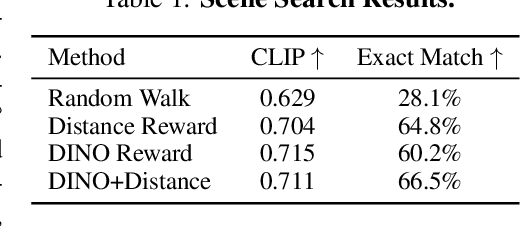



Abstract:Humans do not passively observe the visual world -- we actively look in order to act. Motivated by this principle, we introduce EyeRobot, a robotic system with gaze behavior that emerges from the need to complete real-world tasks. We develop a mechanical eyeball that can freely rotate to observe its surroundings and train a gaze policy to control it using reinforcement learning. We accomplish this by first collecting teleoperated demonstrations paired with a 360 camera. This data is imported into a simulation environment that supports rendering arbitrary eyeball viewpoints, allowing episode rollouts of eye gaze on top of robot demonstrations. We then introduce a BC-RL loop to train the hand and eye jointly: the hand (BC) agent is trained from rendered eye observations, and the eye (RL) agent is rewarded when the hand produces correct action predictions. In this way, hand-eye coordination emerges as the eye looks towards regions which allow the hand to complete the task. EyeRobot implements a foveal-inspired policy architecture allowing high resolution with a small compute budget, which we find also leads to the emergence of more stable fixation as well as improved ability to track objects and ignore distractors. We evaluate EyeRobot on five panoramic workspace manipulation tasks requiring manipulation in an arc surrounding the robot arm. Our experiments suggest EyeRobot exhibits hand-eye coordination behaviors which effectively facilitate manipulation over large workspaces with a single camera. See project site for videos: https://www.eyerobot.net/
Robo2VLM: Visual Question Answering from Large-Scale In-the-Wild Robot Manipulation Datasets
May 21, 2025Abstract:Vision-Language Models (VLMs) acquire real-world knowledge and general reasoning ability through Internet-scale image-text corpora. They can augment robotic systems with scene understanding and task planning, and assist visuomotor policies that are trained on robot trajectory data. We explore the reverse paradigm - using rich, real, multi-modal robot trajectory data to enhance and evaluate VLMs. In this paper, we present Robo2VLM, a Visual Question Answering (VQA) dataset generation framework for VLMs. Given a human tele-operated robot trajectory, Robo2VLM derives ground-truth from non-visual and non-descriptive sensory modalities, such as end-effector pose, gripper aperture, and force sensing. Based on these modalities, it segments the robot trajectory into a sequence of manipulation phases. At each phase, Robo2VLM uses scene and interaction understanding to identify 3D properties of the robot, task goal, and the target object. The properties are used to generate representative VQA queries - images with textural multiple-choice questions - based on spatial, goal-conditioned, and interaction reasoning question templates. We curate Robo2VLM-1, a large-scale in-the-wild dataset with 684,710 questions covering 463 distinct scenes and 3,396 robotic manipulation tasks from 176k real robot trajectories. Results suggest that Robo2VLM-1 can benchmark and improve VLM capabilities in spatial and interaction reasoning.
Robo-DM: Data Management For Large Robot Datasets
May 21, 2025
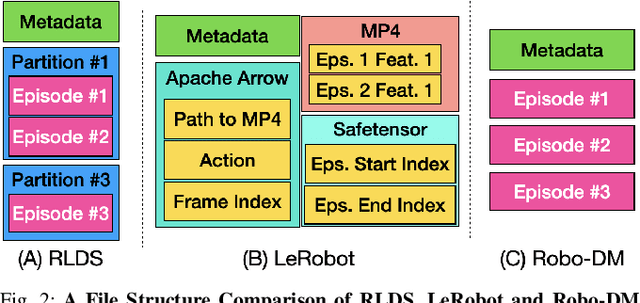


Abstract:Recent results suggest that very large datasets of teleoperated robot demonstrations can be used to train transformer-based models that have the potential to generalize to new scenes, robots, and tasks. However, curating, distributing, and loading large datasets of robot trajectories, which typically consist of video, textual, and numerical modalities - including streams from multiple cameras - remains challenging. We propose Robo-DM, an efficient open-source cloud-based data management toolkit for collecting, sharing, and learning with robot data. With Robo-DM, robot datasets are stored in a self-contained format with Extensible Binary Meta Language (EBML). Robo-DM can significantly reduce the size of robot trajectory data, transfer costs, and data load time during training. Compared to the RLDS format used in OXE datasets, Robo-DM's compression saves space by up to 70x (lossy) and 3.5x (lossless). Robo-DM also accelerates data retrieval by load-balancing video decoding with memory-mapped decoding caches. Compared to LeRobot, a framework that also uses lossy video compression, Robo-DM is up to 50x faster when decoding sequentially. We physically evaluate a model trained by Robo-DM with lossy compression, a pick-and-place task, and In-Context Robot Transformer. Robo-DM uses 75x compression of the original dataset and does not suffer reduction in downstream task accuracy.
GrowSplat: Constructing Temporal Digital Twins of Plants with Gaussian Splats
May 16, 2025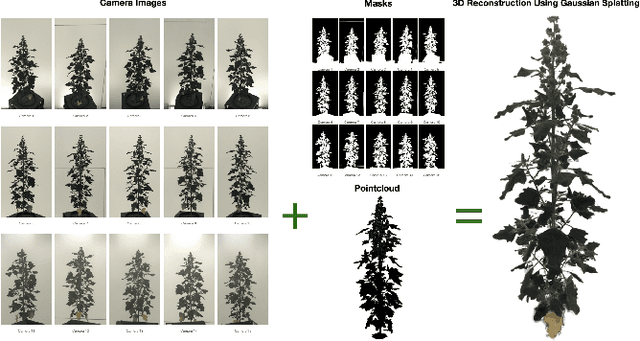
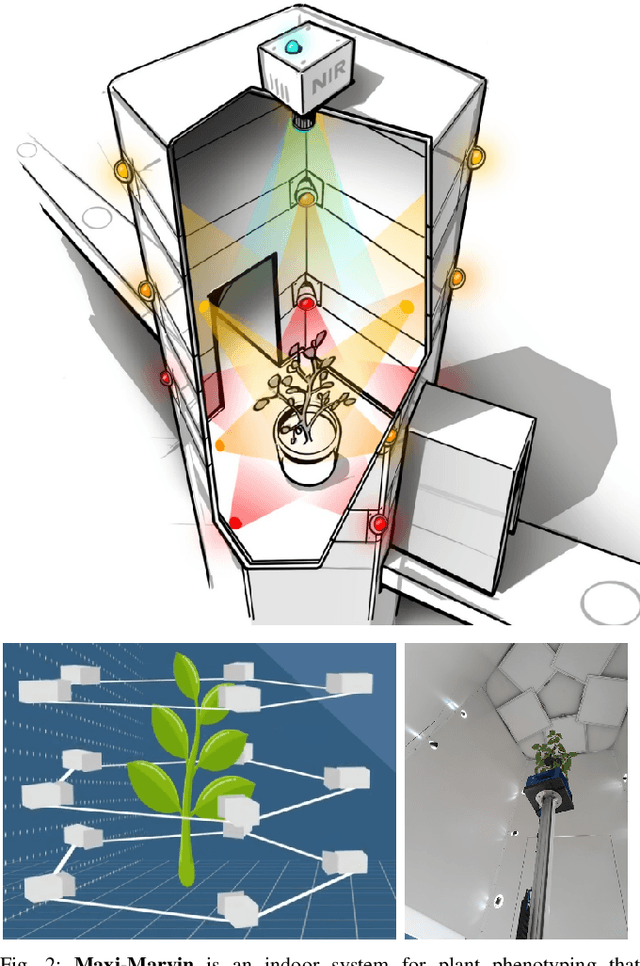
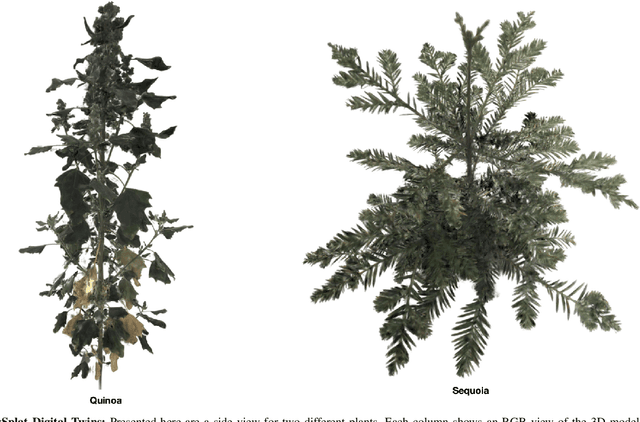
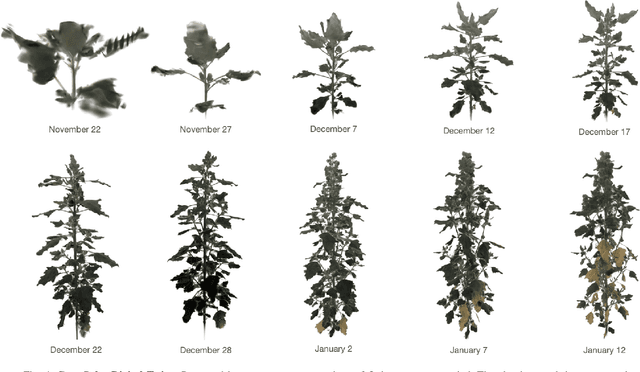
Abstract:Accurate temporal reconstructions of plant growth are essential for plant phenotyping and breeding, yet remain challenging due to complex geometries, occlusions, and non-rigid deformations of plants. We present a novel framework for building temporal digital twins of plants by combining 3D Gaussian Splatting with a robust sample alignment pipeline. Our method begins by reconstructing Gaussian Splats from multi-view camera data, then leverages a two-stage registration approach: coarse alignment through feature-based matching and Fast Global Registration, followed by fine alignment with Iterative Closest Point. This pipeline yields a consistent 4D model of plant development in discrete time steps. We evaluate the approach on data from the Netherlands Plant Eco-phenotyping Center, demonstrating detailed temporal reconstructions of Sequoia and Quinoa species. Videos and Images can be seen at https://berkeleyautomation.github.io/GrowSplat/
Real2Render2Real: Scaling Robot Data Without Dynamics Simulation or Robot Hardware
May 14, 2025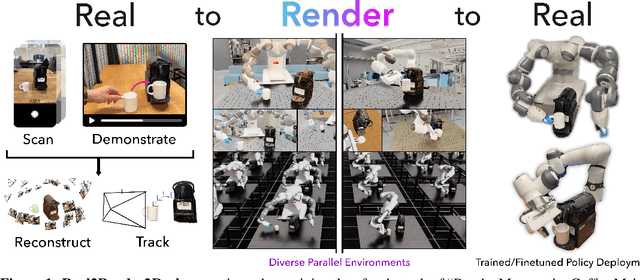
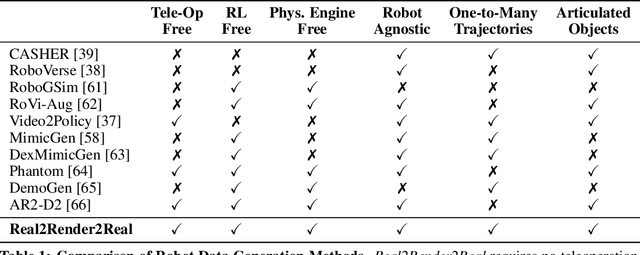
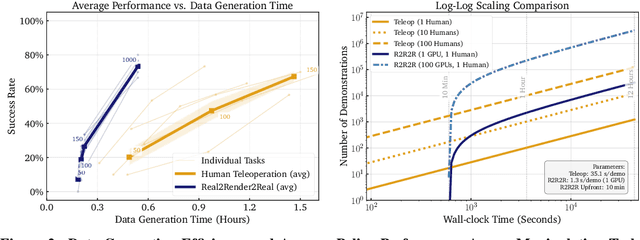
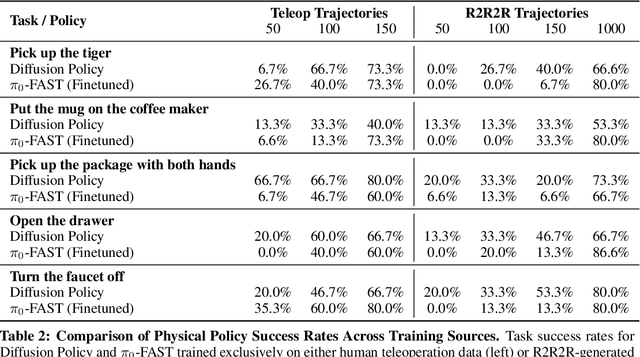
Abstract:Scaling robot learning requires vast and diverse datasets. Yet the prevailing data collection paradigm-human teleoperation-remains costly and constrained by manual effort and physical robot access. We introduce Real2Render2Real (R2R2R), a novel approach for generating robot training data without relying on object dynamics simulation or teleoperation of robot hardware. The input is a smartphone-captured scan of one or more objects and a single video of a human demonstration. R2R2R renders thousands of high visual fidelity robot-agnostic demonstrations by reconstructing detailed 3D object geometry and appearance, and tracking 6-DoF object motion. R2R2R uses 3D Gaussian Splatting (3DGS) to enable flexible asset generation and trajectory synthesis for both rigid and articulated objects, converting these representations to meshes to maintain compatibility with scalable rendering engines like IsaacLab but with collision modeling off. Robot demonstration data generated by R2R2R integrates directly with models that operate on robot proprioceptive states and image observations, such as vision-language-action models (VLA) and imitation learning policies. Physical experiments suggest that models trained on R2R2R data from a single human demonstration can match the performance of models trained on 150 human teleoperation demonstrations. Project page: https://real2render2real.com
PyRoki: A Modular Toolkit for Robot Kinematic Optimization
May 06, 2025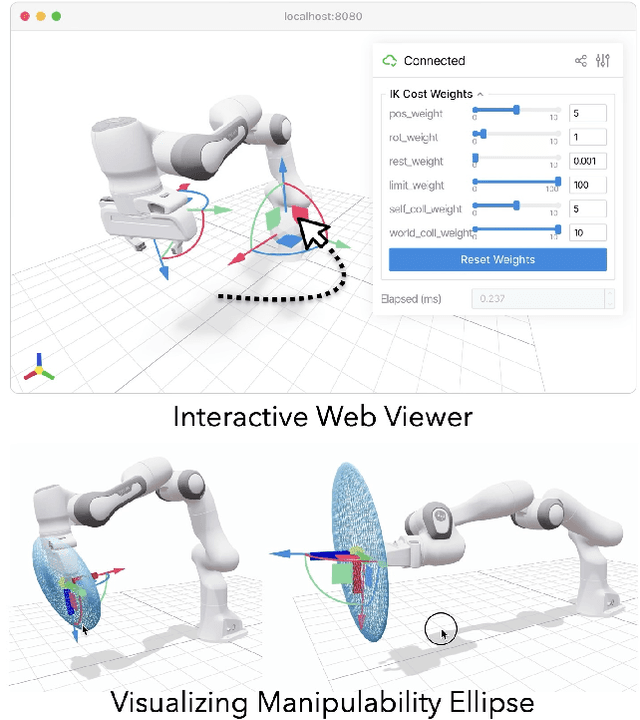
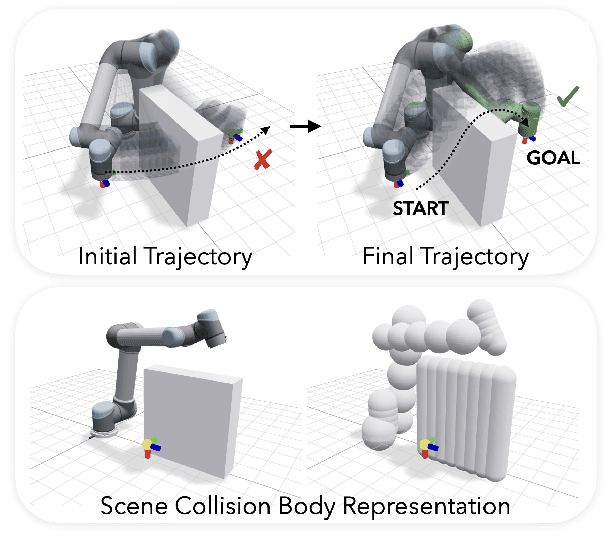
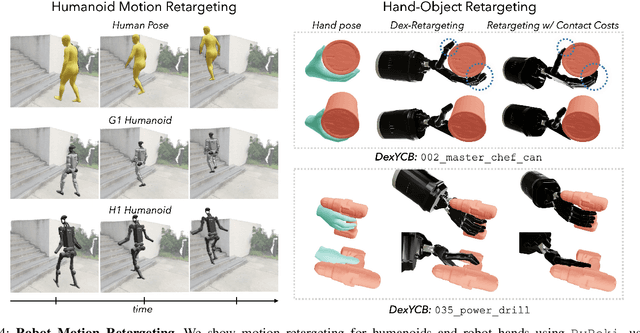
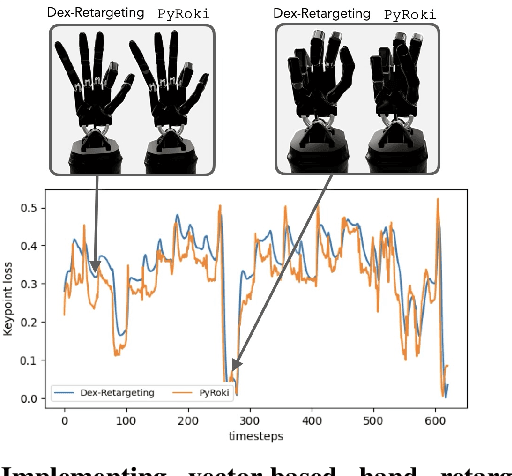
Abstract:Robot motion can have many goals. Depending on the task, we might optimize for pose error, speed, collision, or similarity to a human demonstration. Motivated by this, we present PyRoki: a modular, extensible, and cross-platform toolkit for solving kinematic optimization problems. PyRoki couples an interface for specifying kinematic variables and costs with an efficient nonlinear least squares optimizer. Unlike existing tools, it is also cross-platform: optimization runs natively on CPU, GPU, and TPU. In this paper, we present (i) the design and implementation of PyRoki, (ii) motion retargeting and planning case studies that highlight the advantages of PyRoki's modularity, and (iii) optimization benchmarking, where PyRoki can be 1.4-1.7x faster and converges to lower errors than cuRobo, an existing GPU-accelerated inverse kinematics library.
 Add to Chrome
Add to Chrome Add to Firefox
Add to Firefox Add to Edge
Add to Edge